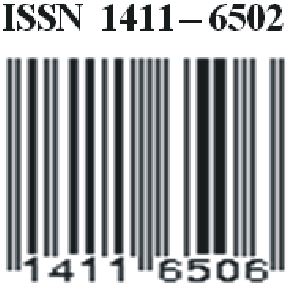Pengaruh Penambahan Poli Vinil Alkohol Terhadap Ukuran dan Kestabilan Nanopartikel Perak Hasil Sintesis Menggunakan Bioreduktor Ekstrak Daun Akasia (Accacia mangium Wild).
(1) Jurusan Kimia Universitas Negeri Makassar
(2) Jurusan Kimia Universitas Negeri Makassar
(3) Jurusan Kimia Universitas Negeri Makassar
(*) Corresponding Author
DOI: https://doi.org/10.35580/chemica.v23i1.33911
Abstract
ABSTRAK
Telah dilakukan penelitian tentang sintesis nanopartikel perak menggunakan bioreduktor ekstrak daun akasia (Accacia Mangium Wild) yang berperan sebagai agen pereduksi. Penelitian ini bertujuan untuk menentukan pengaruh waktu reaksi dan penambahan PVA terhadap kestabilan dan ukuran nanopartikel perak yang terbentuk denganmenggunakan ekstrak daun akasia mangium (Acacia mangium Wild). Nanopartikel perak dibuat dengan variasi konsentrasi PVA yang berbeda-beda yaitu 0%, 1%, 2%, 3%, 4% dan 5%. Proses pembentukan nanopartikel perak dimonitoring dengan mengamati menggunakan spektrofotometer UV-Vis. Hasil penelitian menunjukkan bahwa nilai absorbansi meningkat dengan bertambahnya waktu reaksi dimana PVA digunakan untuk menstabilkan ukuran nanopartikel perak sehingga mencegah aglomerasi pada pembentukan nanopartikel perak.Serapan maksimum UV-Vis dari sampel hasil sintesis dengan konsentrasi PVA yang berbeda-beda yaitu 0%, 1%, 2%, 3%, 4% dan 5% masing-masing pada panjang gelombang 481,00 nm, 433,0 nm, 471,0 nm, 265,0 nm, 455,0 nm dan 419,0 nm selama penyimpanan 4 hari. Ukuran nanopartikel perak ditentukan menggunakan X-Ray Diffraction (XRD) dengan persamaan Dbye Schrrer. Distribusi rata-rata ukuran sintesis nanopartikel perak tanpa penambahan PVA yaitu 17,0 - 20,48 nm sedangkan dengan penambahan PVA ukuran terkecil nanopartikel perak mencapai 7,82 – 17,30 nm pada konsentrasi PVA 2%. Morfologi nanopartikel perak diamati dengan Scanning Electron Microscope (SEM), terlihat partikel tidak memiliki pori dan bentuk partikel yang tidak seragam.
Kata kunci: Ekstrak Daun Akasia, Nanopartikel Perak, Reduksi, dan Poli Vinil Alkohol.
ABSTRACT
Research has been carried out on the synthesis of silver nanoparticles using a bioreductor of acacia leaf extract (Accacia Mangium Wild) which acts as a reducing agent. This study aims to determine the effect of reaction time and the addition of PVA to the stability and size of silver nanoparticles formed using acacia mangium leaf extract (Acacia mangium Wild). Silver nanoparticles were made with varying concentrations of PVA which are 0%, 1%, 2%, 3%, 4% and 5%. The process of forming silver nanoparticles was monitored by a UV-Vis spectrophotometer. The results showed that the absorbance value increased with increasing reaction time where PVA was used to stabilize the size of silver nanoparticles thus preventing agglomeration in the formation of silver nanoparticles. The maximum absorption of UV-Vis from the synthesized samples with different PVA concentrations was 0%, 1%, 2%, 3%, 4% and 5% at wavelengths of 481,0 nm, 433,0 nm, 471,0 nm, 265,0 nm, 455,0 nm and 419,0 nm for 4 days of storage . The size of silver nanoparticles was determined using X-Ray Diffraction (XRD) with the Dbye Schrrer equation. The average distribution of the size of silver nanoparticles synthesis without the addition of PVA is 17,0 – 20,48 nm while with the addition of PVA the smallest size of silver nanoparticles reaches 7,82 – 17,30 nm at a concentration of 2% PVA. The morphology of silver nanoparticles was observed by Scanning Electron Microscope (SEM). It is seen that the particles did not have pores and the shape of the particles was not uniform.
Keywords: Acacia Leaf Extract, Silver Nanoparticles, Reduction, and Poly Vinyl Alcohol.
Full Text:
PDFReferences
Agromedia, Redaksi. 2008. Buku Pintar Tanaman Obat . Jakarta: Pt. Agromedia Pustaka.
Bae, E.2011, Effect Of Chemical Stabilizers In Silver Nanoparticle Suspensions On Nanotoxicity. Bull. Korean Chem. Soc, 32 (2), 613-619
Bakir. 2011. Pengembangan Biosintesis Nanopartikel Perak Menggunakan Air Rebusan Daun Bisbul (Diospyros Blancoi) Untuk Deteksi Ion Tembaga (II) Dengan Metode Kolorimetri, Skripsi Diterbitkan, (Online)
pada Tanggal 10 Oktober 2012), Jurusan Fisika FMIPA Universitas Indonesia. Jakarta.
Guzman MG. 2009. Synthesis of silver nanoparticles by chemical reduction method and their antibacterial activity. Int J Chem Biomol Eng 2: 3.
Handayani W. 2010. Potensi Ekstrak Beberapa Jenis Tumbuhan Sebagai Agen Pereduksi Untuk Biosintesis Nanopartikel Perak. Seminar Nasional Biologi Universitas Gadjah Mada. Yogyakarta.
Haryono, A., dan Harmami. 2008, Sintesa Nanopartikel Perak Dan Potensi Aplikasinya, Jurnal Riset Industri, 2 (3). 156-163.
Hasfita, Fikri. Study Pembuatan Biosorben Dari Limbah Daun Akasia Mangium (Acacia Mangium Wild) Untuk Aplikasi Penyisihan Logam. Jurnal Teknologi Kimia Unimal 1:1 (2012) 36-48.
Lembang, Esty Yunita. Zakir, Maming M. 2013. Sintesis Nanopartikel Perak Dengan Metode Reduksi Menggunakan Bioreduktor Ekstrak Daun Ketapang (Terminalia Catappa). Jurnal Penelitian Kimia. 2(1): 3-11.
Lu, Y.C., dan Chou K.S. 2008, A Simple And Effective Route For Synthesis Of Nano Silver Colloidal Dispersions, J. Chin. Ins.Chem. Eng.39. 673-678.
Rochani, S., dan Wahyudi, A. 2010.Peran Nanoteknologi Dalam Pengolahan Mineral. Pusat Penelitian Dan Pengembangan Teknologi Mineral Dan Batubara, 8 (1).
Wahyudi. 2011.Sintesis Nanopartikel Perak Dan Uji Aktivitasnya Terhadap Bakteri E. Coli Dan S. Aureus. Arena Tekstil, 26 (1).1-60.
Yunita, Esty. Renugadevi, K. 2013. Sintesis Nanopartikel Perak Dengan Metode Reduksi Menggunakan Bioreduktor Ekstrak Daun Ketapang (Terminalia Catappa). Jurnal Penelitian. Jurusan Kimia Fakultas Matematika Dan Ilmu Pengetahuan Alam Universitas Hasanuddin Makassar. 1:1 (2013) 36-48.
Article Metrics
Abstract view : 206 times | PDF view : 242 timesRefbacks
- There are currently no refbacks.
ISSN: 2722-8649
Diterbitkan oleh Jurusan Kimia FMIPA Universitas Negeri Makassar (UNM) dua kali dalam setahun yaitu bulan Juni dan Desember.
Alamat Redaksi :Jurusan Kimia, Fakultas MIPA UNM, JL. Dg. Tata Parangtambung, Makassar 90224 Indonesia, Telp. 0411-840295; Fax: 0411840295;E-mail : [email protected]




